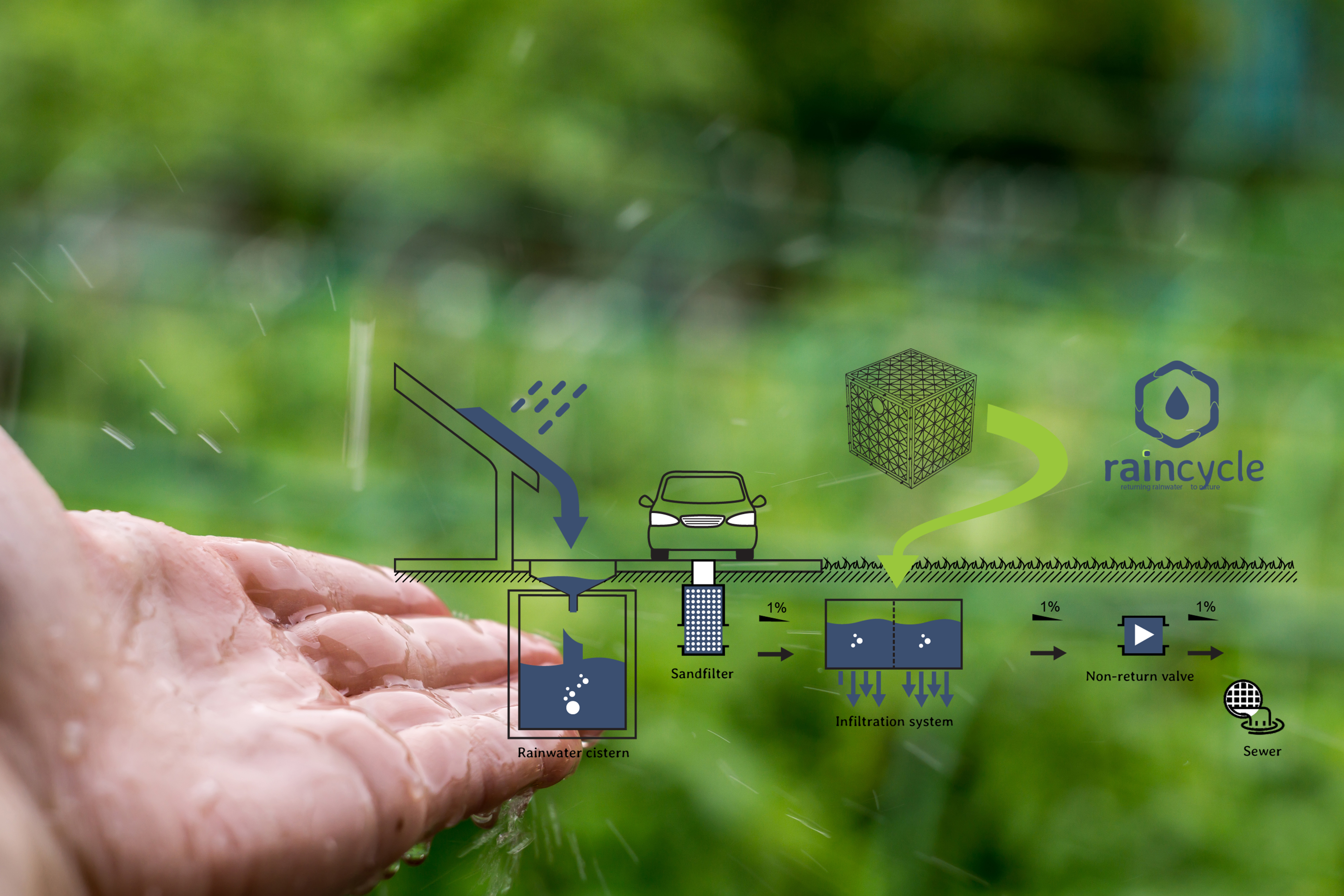Rainwater management with a unique all-in-one system
Giving Mother Nature a helping hand!
Rainwater is one of the most valuable resources there is. Yet every day we let thousands of liters of clean rainwater disappear into the sewer system. We rarely give it a moment's thought, but this can be costly both for society and for our ecosystem.
When presented with a problem, we are ingenious at coming up with solutions. With each solution, however, new problems emerge. The good news is that we almost always manage to come up with still more clever, unexpected solutions.
Rainwater infiltration systems such as Raincycle ensure that rainwater is gradually released into the ground in a controlled way. Via the groundwater, the rainwater is returned to the natural water cycle. You could say that we're giving Mother Nature a helping hand.
Reducing the chance of flooding
Rainfall is the most important factor
Put simply, floods occur when the amount of water flowing from a catchment exceeds the capacity of its drains, creeks, and rivers. This process begins with rainfall but is affected by many other factors.
Extreme rainfall events resulting in flooding across many cities around the world has necessitated measures to reduce the scope of the damage. This has forced governments to initiate actions towards the impact of climate change on local conditions and adaptation/mitigation actions that can fit into decision-making processes.
During periods of heavy rainfall, Raincycle infiltration systems also reduce the chance of flooding. The high degree of permeability of this kind of system means that large quantities of water can be infiltrated into the ground in a controlled manner. This is advantageous because a sudden large influx of rainwater into the sewers can cause major problems.
The Drainage System
Drainage system
If the ground nevertheless becomes saturated with groundwater after a persistent downpour, the overflow of the infiltration system removes the excess water to the sewer system. And since the geotextile allows groundwater to seep into the crates, Raincycle also functions as a drainage system.
Waterlogged lawns and puddles in the flowerbeds will be a thing of the past.
What about legislation?
EU policy (EØS) as well strongly promotes the implementation of rainwater infiltration measures. The legislation is in the pipeline to make the use of infiltration systems compulsory in both new-build and renovation projects.
ADVANTAGES
Quick & compact
Each Raincycle infiltration crate is made up of seven individual panels, which can be fitted together to make a box shape in no time. The panels are already covered with a 100% water-permeable geotextile membrane. Once a crate has been assembled, it is fully ready for use. Raincycle infiltration crates are not pre-assembled, so they can be compactly packed and transported, which also reduces their environmental footprint.
Modular
Raincycle engineers have developed a very simple system that is suitable for both DIY and professional use. Unlike most Industrial systems, Raincycle has been designed for small and medium-sized projects, such as car parks, residential homes, and apartment buildings. It consists of separate modules that are connected together to form a customized unit. No need for specialized companies to do complicated calculations.
You simply combine as many modules as you need.
Environmentally responsible
To complete the picture, Raincycle Always opts for sustainable and recycled materials. This means that we are committed to using environmentally responsible plastics, which can be fully recycled again. In this way, Raincycle contributes to the circular economy. Click PDF to download Raincycle
CONNECTION
Direct connection to the drains
When the drains collecting rainwater from the roof, patio or car park are directly connected to Raincycle (without a rainwater cistern), it is important to place a sand filter upstream of the infiltration crates to prevent dirt and sand fouling the infiltration system. If the infiltration system overflow is connected to the sewers, a non-return valve should be fitted.
Lay all pipes with a fall of 1 cm per meter to ensure that the water runs freely.
Connection to the drains via a rainwater cistern
When the drains collecting rainwater from the roof, patio or car park are connected to a rainwater cistern, the infiltration crates are directly connected to the overflow. If the infiltration system overflow is connected to the sewers, a non-return valve should be fitted.
Lay all pipes with a fall of 1 cm per meter to ensure that the water runs freely.
ASSEMBLY AND INSTALLATION
CONTACT FORM & INFO
I AM AT YOUR SERVICE
Dear Customer. Please fill in the form and I will do my utmost to provide you with the best solution. Thank you so much in advance

.png)













